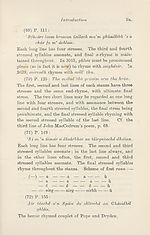Download files
Complete book:
Individual page:
Thumbnail gallery: Grid view | List view

Iviii.
Introduction
anc© is between the second and fourth stressed syllables;
in the other lines, it is between the second and third.
In the fourth line, the second and third assonances agree
with the second and fourth of the third line. The lines
of each stanza have the same end-rhyme, except the
third, which rhymes with two words in the next line.
In 1. 1842, for nach ’eil we should probably read nach
bhfhuil, to rhyme in quality though not in quantity with
giidan, luthmhor. Scheme of first stanza, which is less
regular than the others : —
a — i I — o —
a i (u) — e — i
ui i — i — o —
— a a o — a —
a a a — a —
(68) P. 104:
’S iomadh bdiutighearn’ bha speiseil mu’n cheile.
bh’aig Mdraig.
A complicated metre. Each long line has four stresses.
In the first two lines the vowel sequence is the same,
except in the first stressed syllable. The third and fifth
lines are homogeneous, i.e., they have the same vowel
sequence. The fourth and sixth lines have each a
syllable rhyming with the final stressed syllable of the
previous line. The final stressed syllables rhyme
throughout the stanza. By arrangement of the stress
in the third and fifth lines, the poet obtains a staccato
effect resembling the phrasing of part of a pibroch.
Scheme of the first stanza : —
(2) — a — — 'e e 6 —
(3) i 1 i - 6 -
(4) —ua 6 a o —
(5) i i 1 — 6 -
(6) — — o 6 o 6 —
Introduction
anc© is between the second and fourth stressed syllables;
in the other lines, it is between the second and third.
In the fourth line, the second and third assonances agree
with the second and fourth of the third line. The lines
of each stanza have the same end-rhyme, except the
third, which rhymes with two words in the next line.
In 1. 1842, for nach ’eil we should probably read nach
bhfhuil, to rhyme in quality though not in quantity with
giidan, luthmhor. Scheme of first stanza, which is less
regular than the others : —
a — i I — o —
a i (u) — e — i
ui i — i — o —
— a a o — a —
a a a — a —
(68) P. 104:
’S iomadh bdiutighearn’ bha speiseil mu’n cheile.
bh’aig Mdraig.
A complicated metre. Each long line has four stresses.
In the first two lines the vowel sequence is the same,
except in the first stressed syllable. The third and fifth
lines are homogeneous, i.e., they have the same vowel
sequence. The fourth and sixth lines have each a
syllable rhyming with the final stressed syllable of the
previous line. The final stressed syllables rhyme
throughout the stanza. By arrangement of the stress
in the third and fifth lines, the poet obtains a staccato
effect resembling the phrasing of part of a pibroch.
Scheme of the first stanza : —
(2) — a — — 'e e 6 —
(3) i 1 i - 6 -
(4) —ua 6 a o —
(5) i i 1 — 6 -
(6) — — o 6 o 6 —
Set display mode to:
![]() Universal Viewer |
Universal Viewer | ![]() Mirador |
Large image | Transcription
Mirador |
Large image | Transcription
| An Comunn Gàidhealach > An Comunn Gàidhealach Publications > Bàrdachd Ghàidhlig > (62) |
|---|
| Permanent URL | https://digital.nls.uk/126455762 |
|---|
| Description | This contains items published by An Comunn, which are not specifically Mòd-related. It includes journals, annual reports and corporate documents, policy statements, educational resources and published plays and literature. It is arranged alphabetically by title. |
|---|
| Description | A collection of over 400 items published by An Comunn Gàidhealach, the organisation which promotes Gaelic language and culture and organises the Royal National Mòd. Dating from 1891 up to the present day, the collection includes journals and newspapers, annual reports, educational materials, national Mòd programmes, published Mòd literature and music. |
|---|---|
| Additional NLS resources: |
|

